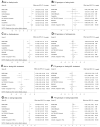Common variation in the FTO gene alters diabetes-related metabolic traits to the extent expected given its effect on BMI
- PMID: 18346983
- PMCID: PMC3073395
- DOI: 10.2337/db07-1466
Common variation in the FTO gene alters diabetes-related metabolic traits to the extent expected given its effect on BMI
Abstract
Objective: Common variation in the FTO gene is associated with BMI and type 2 diabetes. Increased BMI is associated with diabetes risk factors, including raised insulin, glucose, and triglycerides. We aimed to test whether FTO genotype is associated with variation in these metabolic traits.
Research design and methods: We tested the association between FTO genotype and 10 metabolic traits using data from 17,037 white European individuals. We compared the observed effect of FTO genotype on each trait to that expected given the FTO-BMI and BMI-trait associations.
Results: Each copy of the FTO rs9939609 A allele was associated with higher fasting insulin (0.039 SD [95% CI 0.013-0.064]; P = 0.003), glucose (0.024 [0.001-0.048]; P = 0.044), and triglycerides (0.028 [0.003-0.052]; P = 0.025) and lower HDL cholesterol (0.032 [0.008-0.057]; P = 0.009). There was no evidence of these associations when adjusting for BMI. Associations with fasting alanine aminotransferase, gamma-glutamyl-transferase, LDL cholesterol, A1C, and systolic and diastolic blood pressure were in the expected direction but did not reach P < 0.05. For all metabolic traits, effect sizes were consistent with those expected for the per allele change in BMI. FTO genotype was associated with a higher odds of metabolic syndrome (odds ratio 1.17 [95% CI 1.10-1.25]; P = 3 x 10(-6)).
Conclusions: FTO genotype is associated with metabolic traits to an extent entirely consistent with its effect on BMI. Sample sizes of >12,000 individuals were needed to detect associations at P < 0.05. Our findings highlight the importance of using appropriately powered studies to assess the effects of a known diabetes or obesity variant on secondary traits correlated with these conditions.
Figures




References
-
- Obesity: preventing and managing the global epidemic. Report of a WHO consultation. World Health Organ Tech Rep Ser. 2000;894:i–xii. 1–253. - PubMed
-
- Must A, Spadano J, Coakley EH, et al. The disease burden associated with overweight and obesity. JAMA. 1999;282:1523–1529. - PubMed
-
- Dina C, Meyre D, Gallina S, et al. Variation in FTO contributes to childhood obesity and severe adult obesity. Nat Genet. 2007;39:724–726. - PubMed
Publication types
MeSH terms
Substances
Grants and funding
- Z99 AG999999/ImNIH/Intramural NIH HHS/United States
- BHF_/British Heart Foundation/United Kingdom
- GR069224/WT_/Wellcome Trust/United Kingdom
- DH_/Department of Health/United Kingdom
- 072960/WT_/Wellcome Trust/United Kingdom
- 090532/WT_/Wellcome Trust/United Kingdom
- G0500539/MRC_/Medical Research Council/United Kingdom
- GR072960/WT_/Wellcome Trust/United Kingdom
- 069224/WT_/Wellcome Trust/United Kingdom
- G9815508/MRC_/Medical Research Council/United Kingdom
- 079557/WT_/Wellcome Trust/United Kingdom
- G0600705/MRC_/Medical Research Council/United Kingdom
LinkOut - more resources
Full Text Sources
Other Literature Sources
Medical

